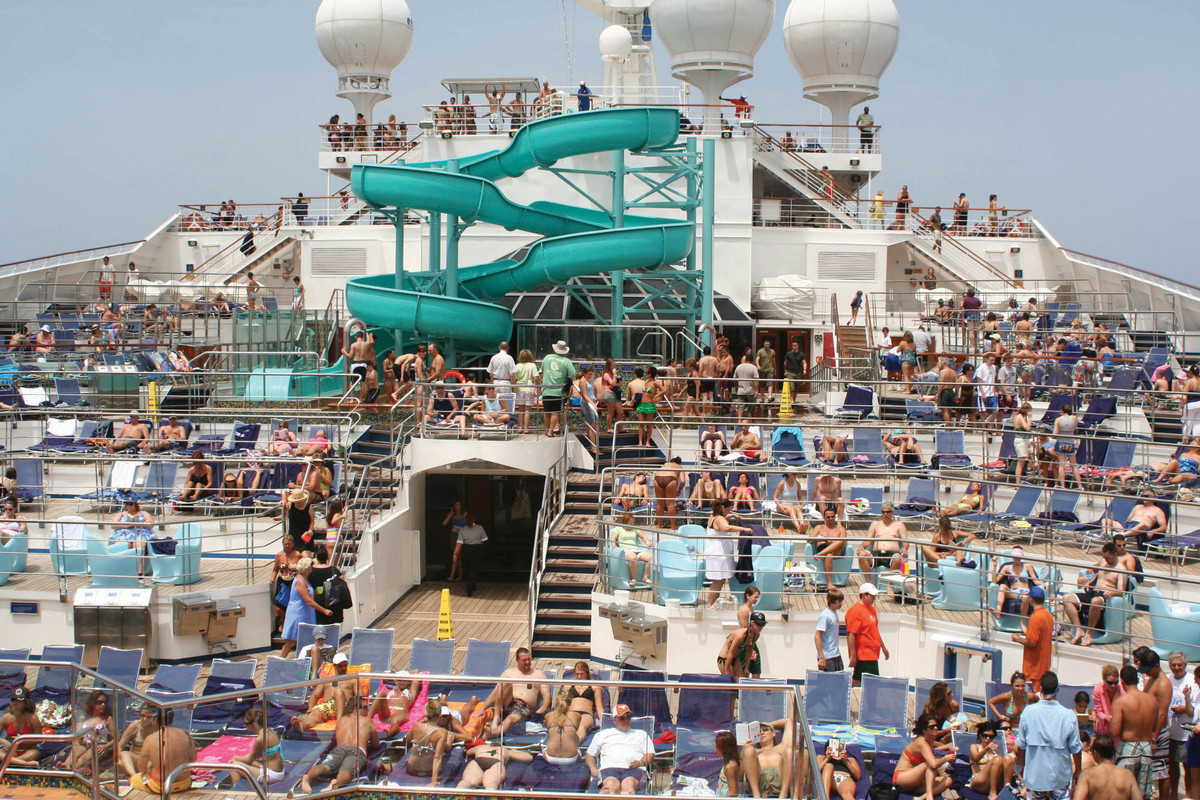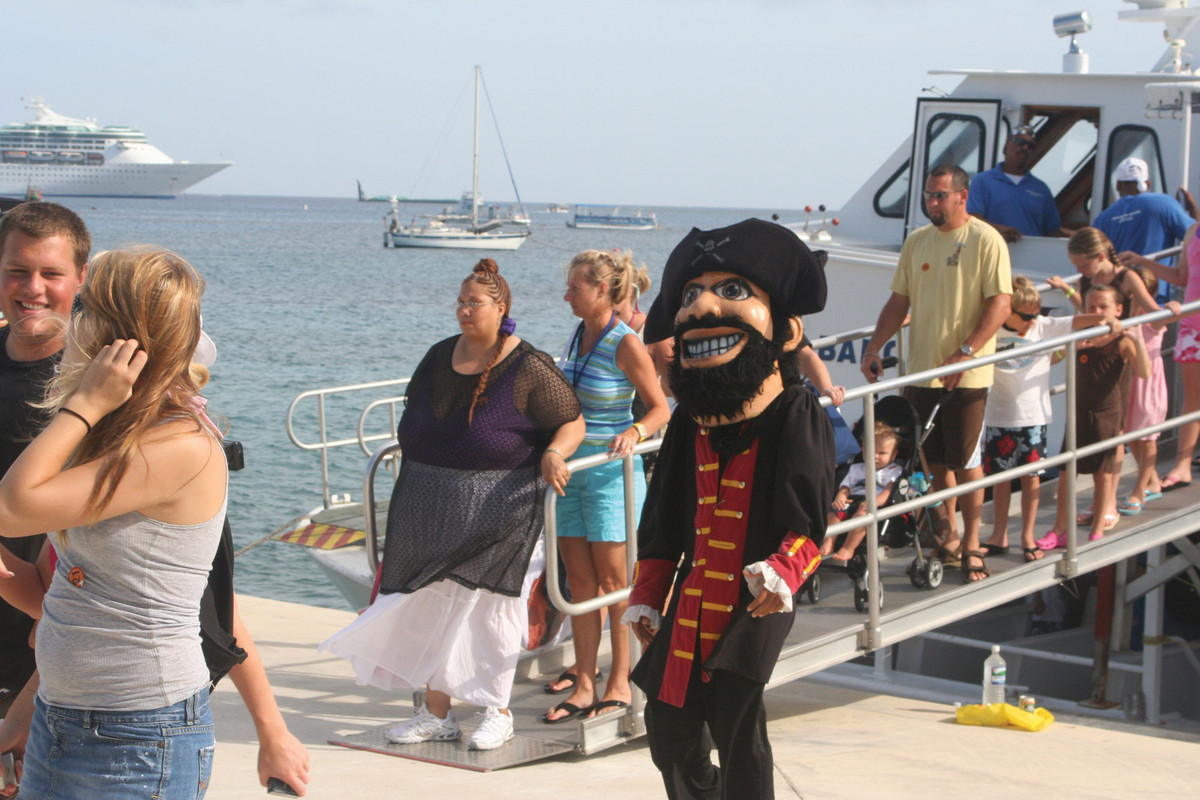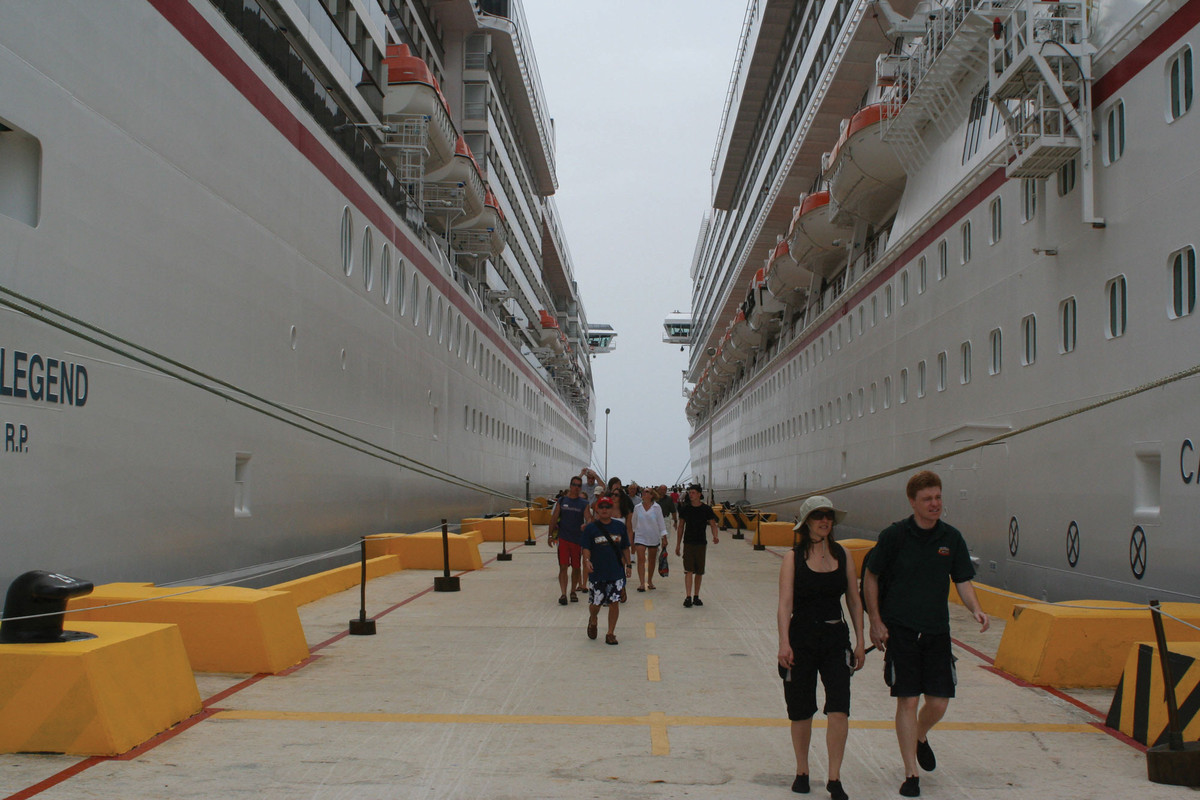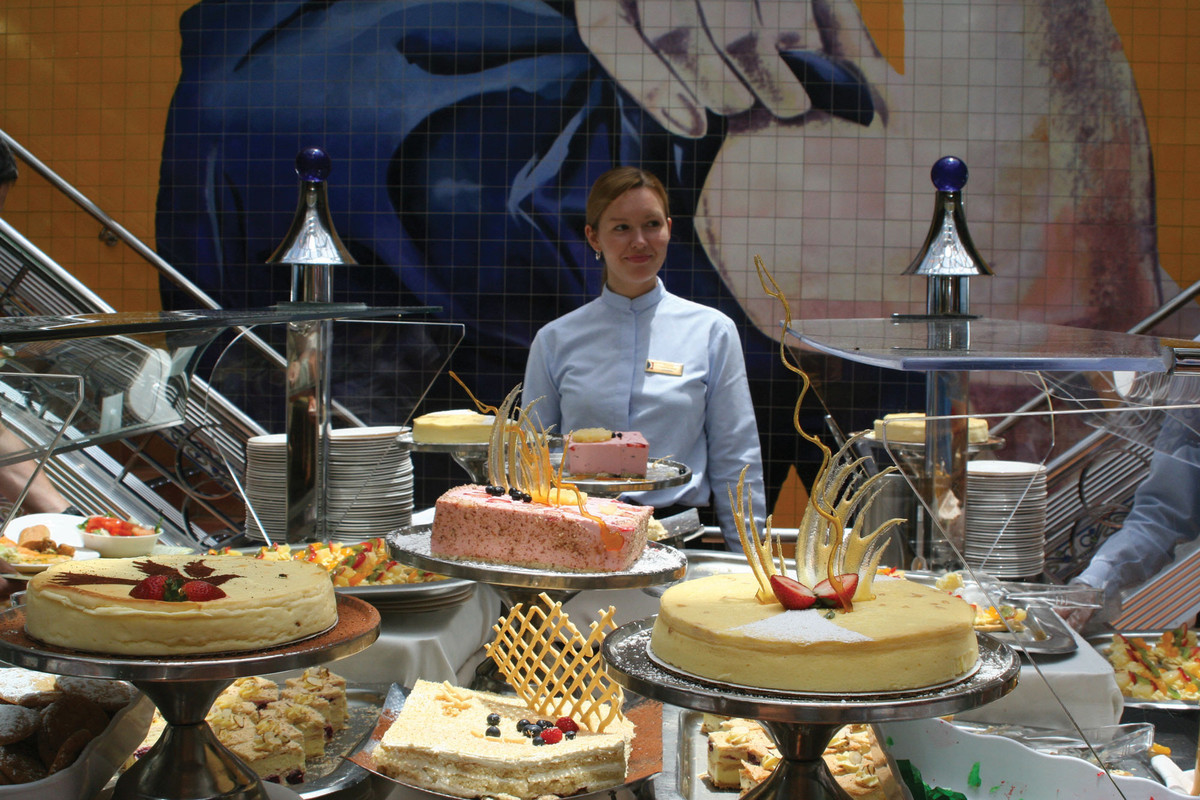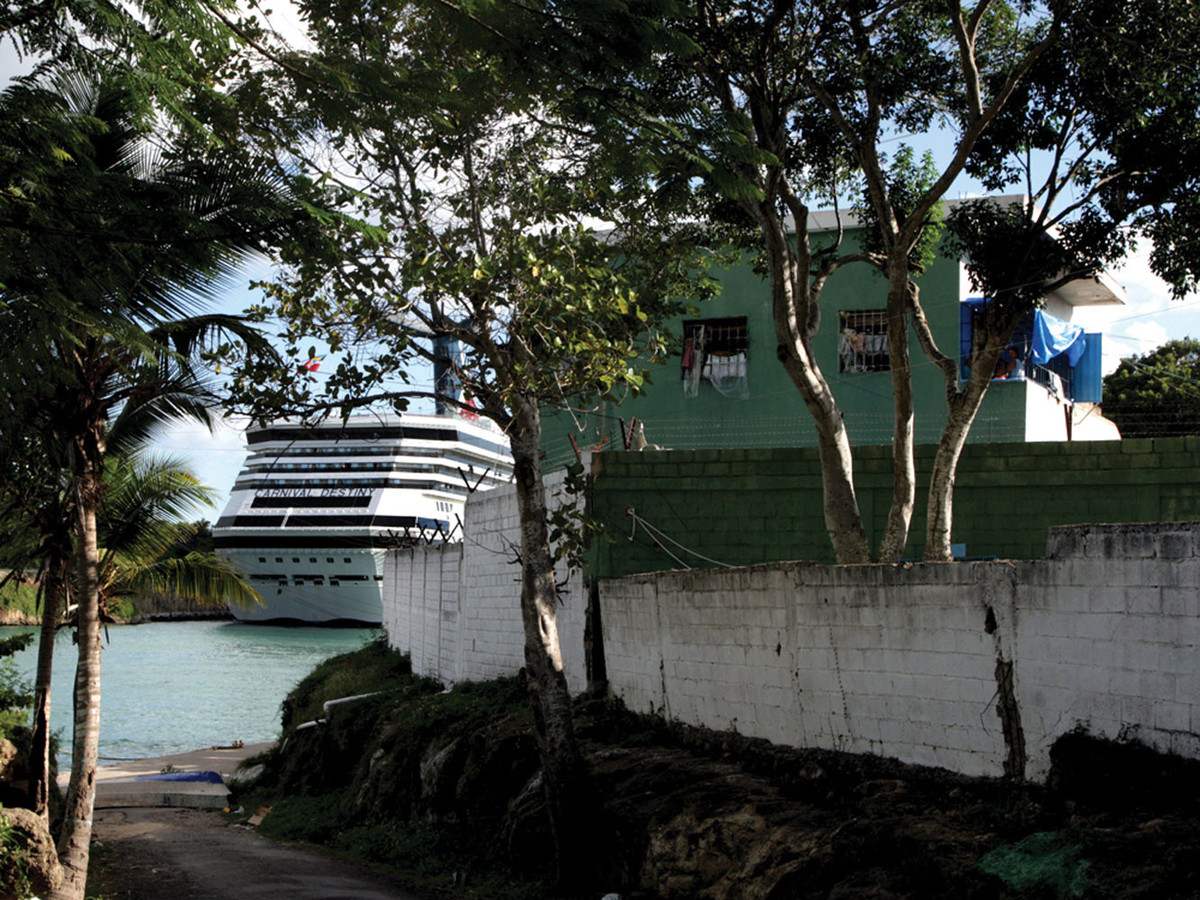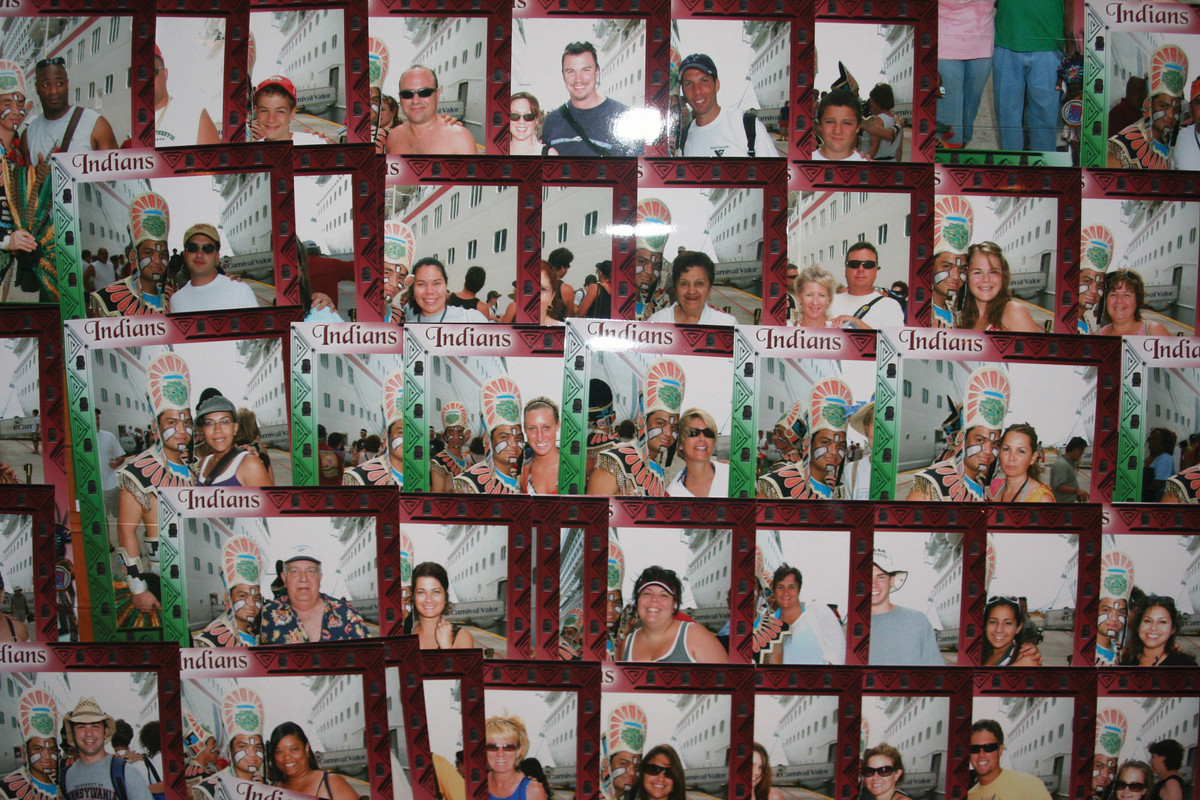Destination Whatever: Touring the Cruise Industry of the Caribbean
With open, smiling mouths and wide,
fixated eyes, a group of racially diverse “wholesome” families is featured against
the new slogan of Royal Caribbean: “Our ships are designed to WOW.”
Notable here is the emphasis on the ships’ design, rather than on any
particular destination. As ships become
more extreme in size, scale, and amenities,
the travel experience is designed to make the floating vacation a familiar and comfortable one. The process of
interiorizing hundreds of atmospheres
into one floating mega-container has
much to do with design, engineering, and
management—but mostly economics.
And the effects of the current generation of cruise tourism in the Caribbean are only beginning to unfold. Adrenaline Beach, Barefoot Beach Club, Dragon’s Plaza. Entering Columbus Cove, Freedom of the Seas sails into Royal Caribbean’s Buccaneer’s Bay. The bay is flanked by recreational attractions including the world’s longest zip line, Dragon’s Breath, and the Dragon’s Tail Coaster atop Santa Maria Mountain. The only landmark is the 19th-century citadel sitting above the horizon—3,000 feet above sea level. The fortress is named for Henri Christophe Laferrière, a key leader of the first black slave rebellion that lead Haiti to independence from the French in 1804.
The boat, Royal Caribbean’s flagship, docks on the northwestern coast of Hispaniola Island, a territory called Labadee®—a registered trademark. Royal Caribbean leased the peninsula from the Haitian government on a 99-year contract. According to Royal Caribbean’s Port Explorer & Shopping Guide, the leased land is “strengthening the cooperative effort between the government of Haiti and RCCL® […] and has been solidified by extensive on-site development through the company’s investment of tens of millions of dollars.” Testifying to the economic humanitarianism of the deal, the guide mentions that “it is a clear vote of confidence in the people, nation, and future of the country as our guests continue to have the exclusive opportunity to enjoy a relaxing fun-filled day in the clear blue waters of Haiti’s northern coast. The sailors who joined Christopher Columbus and first came ashore here centuries ago obviously knew a good thing when they saw it.”
Since the 1980s, RCCL® has held exclusive rights to docking at the once small fishing village and coastal town of Labadie, named for the first French settler in the late 17th century. Anglicized, Labadee® “was specifically designed and built to provide guests with a variety of opportunities to have fun in the sun.” As the guide claims, Royal Caribbean “is honored and proud to be a pioneering partner with a people and country which has such a rich heritage and the tremendous potential to become one of the Caribbean’s premier tour destinations.”
These private destinations—compounds really—have become the new ports of call for big cruise ships. Today, nearly 10 private islands are owned by eight major cruise operators in the Caribbean. By buying or leasing islands, or anchoring at unregulated, deserted stretches of beach, cruise operators can reduce the number of days in official ports and divert the expenditures of travelers to locations under control of the industry. Piers, once perceived as extensions of land that connected ship to destination, have today become extensions of ships. Usually fenced or cordoned off, these extensions are fictional territory: they guide travelers away from local neighborhoods and people, toward areas owned and scripted by cruise companies. They are programmed to deliver isolated, worry-free experiences, supplementing those offered by the ship itself—pristine water, white sand, Caribbean beaches. Off-site excursions are limited to day-trips to tourist-friendly destinations—a colonial city or pre-Hispanic archaeological ruin.
Bigger Boats, Bigger Piers
As ships grow, they become destinations in themselves, ultimately devaluing the role of land-based destinations. From the already impressive 961-foot, 2,200-passenger Queen Elizabeth in the late 1960s, the size and scale of cruising vessels has nearly tripled to a whopping 6,300 passengers (Royal Caribbean’s Allure of the Seas). The increase in size of cruise ships, in width as much as in height, enables considerable spatial and programmatic complexity—streets, entertainment spaces, dining rooms, bars, pools, stores, water parks—with nonstop events that keep passengers entertained, day and night. Ships are designed as small, floating cities. Like an urban theme park, the ships include a multiplicity of landscape decks, terraces, surfing pools, and running paths that consume all available space on the ship’s roof deck.
Although the layout of vessels is organized around a double-loaded corridor down the middle—the “main street,” which provides each room with exterior views and direct access to amenities—it is the central kitchen that forms ships’ cores and ensures their functionality. Precisely engineered and impeccably designed, ship kitchens provide food tailored to a wide range of dining experiences, from luxurious, romantic dinners to basic midday snacks. Upwards of 15,000 meals can be served in one day, delivered through 30 different menus. Onboard infrastructure is vital: desalination plants for drinking water, crushing and compacting systems for recyclables, dehydrators and incinerators for food waste, with leftover ash disposed of offshore.1
The bigger the boat, the more plush the interiors; the more exotic the entertainment, the less relevant the destination. These floating worlds, with their new interior- ized experiences, pay off. Onboard sales of goods now outpace ticket sales as the primary producer of profits, especially on Disney Cruise Lines, where the average passenger spends over $1,000 on a eight-day trip, making five-star resorts comparatively less expensive.2
While Caribbean destinations compete for the business of these floating hotels, the investment expected of ports to build and maintain big piers is ballooning, and is oftentimes out of reach. If Caribbean ports of call are unable to expand and modernize pier infrastructure to accommodate the increasing size of ships, tour operators look elsewhere for destinations that comply with burgeoning demand. In some cases, cruise companies share responsibility and investment for upgraded infrastructure with local partners. In other—more profitable—cases, they develop, manage, and operate ports themselves. Meanwhile, at “outdated” facilities, cruise companies negotiate anchoring fees to meager sums. Faced with growing congestion in the Caribbean and stiff competition from emerging economies worldwide, a port’s inability to upgrade leads to the danger of obsolescence and abandonment. This threat leaves ports paralyzed: investing large sums of money to upgrade facilities only leads to subsequent obsolescence, but not upgrading means no business at all.
As cruise lines operate more and more independently, distance between travelers and islanders grows at an alarming rate, with dramatic levels of dispossession and inequity. For example, Royal Caribbean was noticeably absent in the immediate aftermath of the 2010 earthquake in Haiti, but provided continuous service to Labadee®. Indifferent to the crisis, President and CEO of RCCL® Adam Goldstein admitted on National Public Radio that the decision to keep business going as usual, on the edge of a disaster zone, was a “pretty easy decision […] a no-brainer.”3 Although the Haitian government requested that they maintain their voyages for both economic benefits and some relief efforts (they provided the transport of goods), maritime lawyer Jim Walker questioned motivations by asking, “Is it appropriate to sail into the idyllic port of Labadee, Haiti on a pleasure cruise when the dead remain unburied and the impoverished country writhes in chaos?”4
Cruise line operators now sometimes work like infrastructure banks, offering loans to governments at local destinations to fund cruise-based infrastructure projects. In 2007, Carnival Corporation PLC and St. Maarten signed a $34.5 million agreement for the enlargement of their pier, anticipating bigger ships to revive the tourist economy in the British Virgin Islands. Destinations have no choice: upgrade their piers or die.
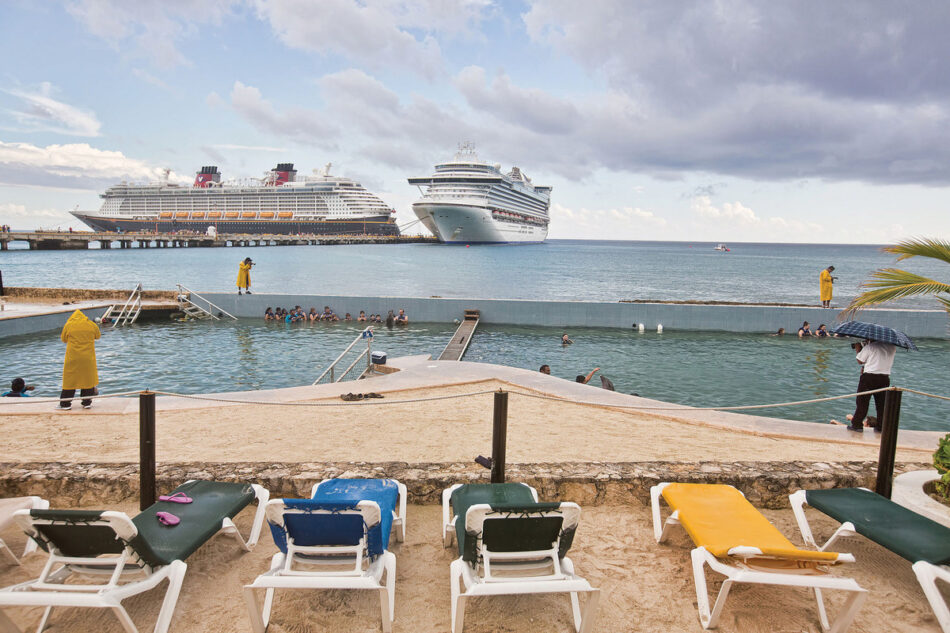
Caribbean Incorporation
The majority of cruises sail to the Caribbean and serve a primarily North American market, but not a single ship that cruises the Caribbean is Caribbean-owned—or US-owned, for that matter. Company headquarters are often on US soil, but most companies sidestep US incorporation and go offshore to avoid high taxation. Carnival (#1 in terms of market share), which owns Holland America Line (#4), is incorporated in Panama; Royal Caribbean (#2) is “based” in Liberia; and Norwegian Cruise Line (#3) is registered with the Genting Group in Malaysia. It’s a matter of economics. As journalist Elizabeth Becker noted, “during its two-decades-long civil war, Liberia earned at least $20 million every year by acting as the offshore registry for foreign ships.”5
For the past decade, cruise tourists have made up about 40 percent of all tourists in the Caribbean, yet they have accounted for less than 10 percent of overall tourist expenditures. Despite periodic efforts to raise port passenger fees, they remain extremely low in the Caribbean. Bermuda charges $60 per visitor, far more than the majority of islands, which often charge less than $10 per visitor. Efforts by Caribbean islands to form a united front as a way to collectively negotiate with cruise lines have been less than successful. If anything, governments feel compelled to give generous tax exemptions to lure ships into their ports and to contribute to local economies, regardless of how paltry the amounts.6
Black Clouds, Murky Waters
Until 25 years ago, cruising was reserved for the wealthy of Europe and America. But growth in ship capacity has made luxury leisure available at much lower price points, closer to half the earlier cost given inflation. The increase in numbers means a decrease in operational expenditures, making cruising an affordable vacation for a larger population.
But greater economies of scale bring greater risks, with hazards on the rise: technical failures, navigational blunders, sanitation lapses, and health epidemics. For example, any given boat loads 24,000 bottles of water every week, which eventually turn into garbage. Destinations are often unable to treat the massive amount of waste, leading cruise ships to dump tons of it in international waters.7 It was not until 2011 that the Caribbean was designated as a “Special Area” (with regard to garbage only) by MARPOL, the UN-based International Convention for the Prevention of Pollution from Ships that regulates the dumping of waste overboard, including sewage, sludge, garbage, oil, and exhaust.
Although MARPOL was adopted in 1973, ocean dumping is still widely practiced, albeit regulated beyond a certain distance from “the nearest land.”8 Problems at sea don’t end with waste, they start there. The larger the vessel, the bigger the engine, the bigger the risk of repairs, breakdowns, or fires. Shorter periods in port mean lower cycle times for repairs and inspections, much like planes. On February 14, 2013, Carnival’s Triumph, a post-Panamax 102,000-ton cruise ship, was towed into Mobile, Alabama, after being stranded at sea for nearly five days. The ordeal began with an engine fire, which despite being quickly and safely extinguished, resulted in a loss of power and propulsion. The ship floated in the Gulf of Mexico with no running water, no air conditioning, and limited food and fresh water. Carnival’s inability to provide solutions for proper waste disposal for passengers and crew led news media to dub it the “poop cruise.” Carnival offered passengers a full refund in cash, $500, and credit toward another Carnival cruise. One passenger interviewed on the Today Show said of the crisis: “It was like post-natural disaster, but stuck on a boat.”9 A cruise operator like Carnival, with 25 Fun Ships in seven different classes (Fantasy, Triumph, Spirit, Conquest, Splendor, Dream, Sunshine, Vista) sailing to over 60 destinations, is no stranger to disaster on board. In fact, its 1972 inaugural voyage ran aground on a sandbar. And just one year prior to the Triumph disaster, the Costa Concordia (operated by Costa Crociere, a subsidiary of Carnival Corporation) capsized and sank off the coast of Italy, killing 32 passengers.
Jay Herring, former senior officer at Carnival and author of the book The Truth about Cruise Ships, says that safety during these catastrophes is of growing concern as ships become bigger and the number aboard increases. He says that with more than 3,000 passengers, evacuation becomes a major problem: “Imagine you have this little bitty boat, bobbing up and down, and you’re trying to transfer passengers from a ship that’s essentially stationary, walking across a gangway. It’s just so dangerous.”10 The Costa Concordia wreck caused the cost of protection and indemnity insurance to skyrocket despite the fact that the captain was singlehandedly at fault for neglect.
The bigger the ship, the higher the risks. In January 2014, Royal Caribbean had to return its Explorer of the Seas to its port of origin in Cape Liberty, New Jersey, after an outbreak of norovirus symptoms—nearly 20 percent of its 3,000 passengers and 5 percent of its 1,100-person crew suffered from extreme diarrhea and vomiting, setting the record for the highest number of passengers and crew sick onboard a vessel in recent history. Seasickness is no longer just from the seas; nowadays it comes from the ship itself.
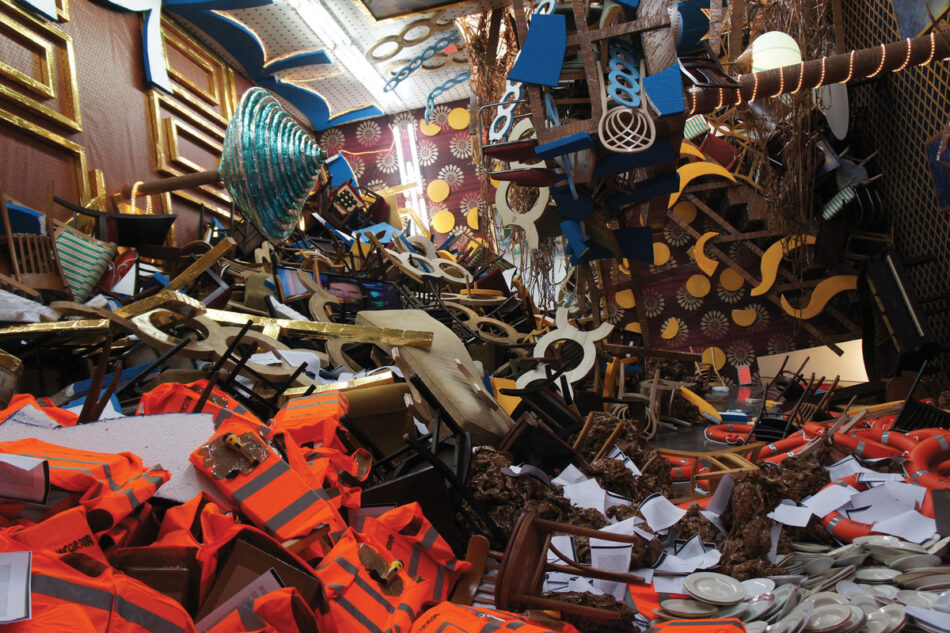
The Terrorism of Tourism
As massive cruise ships sail away from their old ports of call and lay course toward small, nearly uninhabited territories, the ratio between visiting and stable populations on shore shifts. In some isolated islands of the Caribbean, high season produces extreme spikes in population—Cockburn Town, in the Turks Islands, for example, quintuples during peak cruise season, with neither conflict nor negotiation. When boats undock, destination ports and leisure infrastructure are essentially abandoned. Cruising in the Caribbean sometimes results in massive land vacancy, creating idle lands and unoccupied territories that remain unused by locals, melancholically waiting for the arrival of the next floating city to bring meaning and money with it.
Tourism is a global economic force, and the annual growth rate of the cruise industry—around 7 percent—shows remarkable stability.11 This statistic is a testament to the industry’s resiliency, despite recent global recessions. According to the Cruise Line Association, in 1970, cruise ships worldwide carried about 500,000 passengers annually; 40 years later, that number reached over 20 million, a growth of nearly 4,000 percent. In spite of modest beginnings, the three companies that grew the industry have become the largest operators in the world. Norwegian began sailing in 1966, Royal Caribbean in 1968, and Carnival in 1972. These three companies not only survived the advancement of the airline industry as prime examples of transnationalism; the maritime experience of programmed leisure, guaranteed happiness, and catered fun that they provide, it seems, is the perfect antidote for the point-to-point logistics of the aerial age.
But, in an industry nearly monopolized by three companies, competition for exotic destinations grows ever fiercer. The Caribbean and the Mediterranean comprise more than 60 percent of all cruise destinations, with the rest divided between Asia, South America, Alaska, and Australia. During the winter months, two-thirds of cruises travel to the Caribbean. Although the cruise industry, and tourism more broadly, has been relatively successful, its success—calculated in passenger miles and smiles—comes with unknown injustices, where profits often come at the expense of destinations that continue to risk economic atrophy.
If tourism accounts for one of the biggest sectors of the world economy, and cruise tourism is its flagship industry, at what costs must tourism come in the future? And what role do North Americans—as the dominant cruisers—have? The growing inequalities between cruise tourists and largely dispossessed local populations must be addressed, and cruise companies need to be held accountable.
In the foreseeable future, the rise of itineraries to Private DestinationsTM, and FUN© packages designed for 20 million happy passengers, may become hotly contested political issues. The increasingly large, floating fantasies cruising the warm waters of the Caribbean will potentially become economic albatrosses, en route to somewhere other than paradise.
1 See Wendy Littlefield, “How a Cruise Ship Feeds 4,000,” The Atlantic (July 15, 2009), http://www.theatlantic.com/health/archive/2009/07/how-a-cruise-ship-feeds-4-000/21299/2/.
2 Cruise Market Watch, “Financial Breakdown of Typical Cruiser” (2014), http://www.cruisemarketwatch.com/home/financial-breakdown-of-typical-cruiser/.
3 National Public Radio, “Royal Caribbean Provides Tourists, Relief to Haiti” (January 19, 2010).
4 Jim Walker, “Haiti to Charge Royal Caribbean Passengers $2 More to Visit Labadee,” Cruise Law News, August 19, 2014, http://www.cruiselawnews.com/2014/08/articles/caribbean-islands/haiti-to-charge-royal-caribbean-passengers-2-more-to-visit-labadee/.
5 Elizabeth Becker, “Destination Nowhere: The Dark Side of the Cruise Industry,” The Saturday Evening Post (November/December 2013), http://www.saturdayeveningpost.com/2014/04/17/health-and-family/travel/the-dark-side-of-the-cruise-ship-industry.html.
6 Florida-Caribbean Cruise Association, Cruise Industry Overview – 2014: State of the Cruise Industry (Pembroke Pines, FL: FCCA, 2014).
7 Mike Melia, “Caribbean Cruise Ships Dump Garbage at Sea,” Associated Press, March 1, 2009, http://www.sfgate.com/news/article/Caribbean-cruise-ships-dump-garbage-at-sea-3169729.php.
8 See annex 4 and 5 from International Convention for the Prevention of Pollution from Ships, http://www.imo.org/About/Conventions/ListOfConventions/Pages/International-Convention-for-the-Prevention-of-Pollution-from-Ships-(MARPOL).aspx.
9 Quoted in Monica Hesse, “Carnival Triumph Disaster: A Drama of Discomfort,” Washington Post, February 15, 2013, http://www.washingtonpost.com/lifestyle/style/carnival-triumph-disaster-a-drama-of-discomfort/2013/02/15/021265f8-76e2-11e2-8f84-3e4b513b1a13_story.html.
10 Quoted in Scott Neuman, “As Cruise Industry Grows So Have Its Problems,” NPR, February 15, 2013, http://www.npr.org/2013/02/15/172108211/as-cruise-industry-grows-so-have-its-problems.
11 See Jean-Paul Rodrigue with Claude Comtois and Brian Slack, “Transportation, Economy and Society,” in The Geography of Transport Systems, 3rd ed. (New York: Routledge, 2013); and Jean-Paul Rodrigue and Theo Notteboom, “The Geography of Cruises: Itineraries, not Destinations,” Applied Geography 38 (March 2013): 31–42.
* Errata: The print version of this essay incorrectly states that Citadelle Laferrière is 9,840 feet above sea level; it is 3,000 feet above sea level. Additionally, it is not immediately visible from Labadee.
Supersudaca is an architecture and urban research collective founded in 2001 in Rotterdam, and now based in South America and Europe. They use the workshop format with students from various universities worldwide to launch campaigns for projects that contain a highly political component including direct actions on public space, research on Caribbean tourism, experimental housing, rating agencies, and China’s influence in Latin America, among others.

